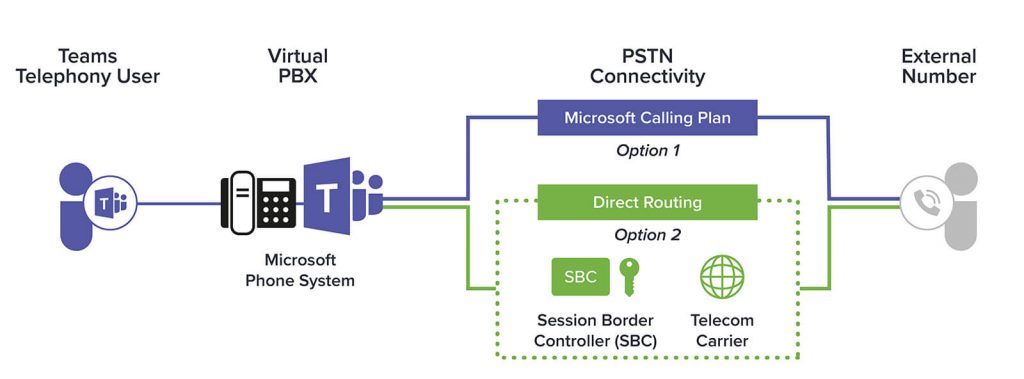As companies look to revamp their digital technologies to support globally distributed workforces, they’re increasingly choosing unified communications platforms like Microsoft Teams. Many organizations are even choosing Microsoft Teams for business telephony to improve the user experience and simplify their IT infrastructure even further.
To use Teams for business telephony, enterprises will need to connect the Microsoft Phone System (a virtual PBX that’s hosted by Microsoft in the cloud) to the public telephony network. That means either using Microsoft Calling Plans or setting up Direct Routing, which is typically done through a managed service provider.
Let’s take a deep dive into the differences between Direct Routing vs Calling Plans. We’ll cover the advantages, disadvantages, and reasons that companies should choose each solution.

Let’s get started.
Microsoft Calling Plans
Microsoft Calling Plans are provided on a per-user-per-month basis and consist of a phone number for inbound calls and a bundle of minutes for outbound calls. This allows users to make and receive external phone calls. Organizations can choose Domestic or International Calling Plans, depending on the needs of users. With these plans, Microsoft acts as the PSTN carrier and provides the connection from Phone System to the public telephony network. Microsoft currently offers Calling Plans to users in 16 countries.
Advantages
Using Microsoft’s Calling Plans, organizations can quickly get started with cloud-based telephony. Companies can rely on Microsoft for all of their telephony needs without searching for third-party providers or PSTN carriers.
If an organization has fairly simple telephony requirements, and all users are located in countries where Calling Plans are offered, then they can be a straightforward solution to consider.
Disadvantages
While Microsoft Calling Plans are simple to deploy, they have some limitations as well.
While the bundle of minutes provided with a Calling Plan is generous and unlikely to be exceeded regularly by users, the monthly license cost is high. By contrast, Direct Routing solutions tend to be more flexible – bundles of minutes can be tailored to the needs of an organization so that they’re not paying for minutes that they’re not using, and the monthly license cost can be significantly lower.
While Calling Plans are fairly straightforward to set up, they’re a self-service solution. This means there’s limited support available for organizations with more complex requirements like call centers or compliant recording. Additionally, it can be challenging to port phone numbers over from existing carriers.
Who Should Use Calling Plans?
Microsoft Calling Plans are straightforward to get started, so they’re a good choice for smaller companies with limited resources or that only operate in one country. Multinational companies may not be able to use Calling Plans in every country that they operate, however. This means that they can’t put all employees onto a globally consistent platform, and some users will miss out on the advantages of unified communications. That’s why larger companies may want to implement Direct Routing instead.
MS Teams Direct Routing
Direct Routing for Microsoft Teams is a way to connect to Microsoft’s Phone System to the public telephony network. Some organizations may choose to do this themselves by sourcing a SIP trunk from a carrier, but most will use a managed service provider like LoopUp for an end-to-end solution. Specialist providers offer a fully managed service, including planning and implementing the migration and training and supporting employees. This is essential for complex, multinational deployments.
The managed provider will help organizations obtain the proper licenses and configure Session Border Controllers (SBCs) to route calls from Microsoft Phone System to the public telephony network. They can also help to optimize the customer’s own corporate network for Teams telephony, for example by using a Media Bypass for improved call routing. They can port DID/DDI phone numbers from the incumbent carrier so that users don’t have to change their phone number, or they can provide new numbers during the migration. You can find out more about how Direct Routing works with our Definitive Guide to Microsoft Teams Direct Routing.
Advantages
Teams telephony can be deployed in far more countries when using a Direct Routing solution in comparison to Microsoft’s Calling Plan package. Cloud telephony is still banned by regulators in a small number of countries, but managed service providers are now able to offer Direct Routing in most countries around the world. They are also able to advise customers so that they comply with local regulatory requirements, which is a complex issue.
Unlike Microsoft Calling Plans, Direct Routing allows organizations to choose bundles or request tailored solutions from providers that meet their carrier and coverage needs. That often means they’re typically cheaper and more flexible than Microsoft’s limited options.
Direct Routing is available as a fully managed service in addition to providing basic PSTN connectivity. They will handle porting of existing numbers, and an integration required with other technology solutions such as call center software or CRM systems.
Disadvantages
Direct Routing solutions are typically more complex than turnkey Microsoft Calling Plan deployments – but this is a function of the specific telephony requirements of each organization. Organizations should review potential suppliers to choose the right one for their business requirements. For example, some providers have a more reliable and robust global network and proven track record than others.
Who Should Use Direct Routing?
Direct Routing is great for organizations that need flexibility, support, and global coverage. Large enterprises can choose a managed provider that fits their specific needs to ensure their entire workforce has support in every region they operate in and often at a much lower cost than Microsoft’s plans.
Want to discover more about the benefits and disadvantages of Direct Routing vs Calling Plans? Download our whitepaper here.
Achieve Truly Unified Communications
As more and more organizations adopt Microsoft Teams for internal collaboration, it only makes sense that integrating external voice calls is the next step. By adopting Microsoft Phone System, enterprises can consolidate their telephony infrastructure and leverage a single platform for organization-wide external communication.
Implementing external communication for Microsoft Teams, therefore, can dramatically improve productivity and collaboration across the organization. Employees can have the flexibility to use Teams on any device from anywhere in the world, which is critical in today’s remote work environment. Meanwhile, IT staff can more easily manage the centralized cloud communication infrastructure and adapt as the workforce changes going forward.
LoopUp—a Microsoft Gold Partner and managed service provider—can further simplify the process for implementing MS Teams Direct Routing. We have a proven track record for providing cloud communication capabilities for over 5,000 enterprises worldwide, including many of the world’s top-100 law firms. LoopUp’s private global network is a reliable solution for achieving truly unified communications across the entire organization.
Still trying to decide which is right for your organization? Reach out to LoopUp and we’ll help you get started on your cloud communication journey.









